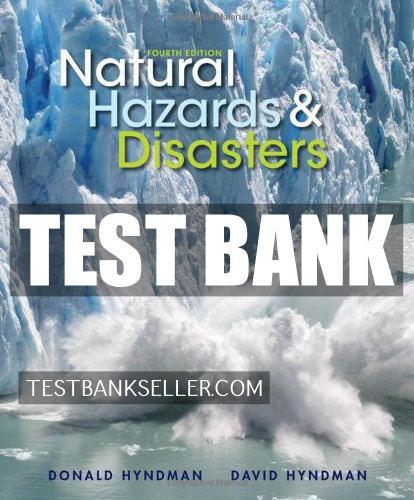Test Bank for Natural Hazards And Disasters 4th Edition by Donald Hyndman
Digital item No Waiting Time Instant DownloadISBN-10: 1133590810, ISBN-13: 9781133590811
In Stock
Original price was: $75.00.$50.00Current price is: $50.00.
Test Bank for Natural Hazards And Disasters 4th Edition by Donald Hyndman
Test Bank Chapter 2
Natural Hazards and Disasters, 4e Plate Tectonics and Physical Hazards
Chapter 2
PLATE TECTONICS AND PHYSICAL HAZARDS
MULTIPLE-CHOICE QUESTIONS
- What direction is the Pacific Plate currently moving, based on the chain of Hawaiian Islands with only the easternmost island active?
- to the northeast
- to the northwest
- to the southeast
- to the southwest
- It is not moving; the chain of islands is not related to the active one.
ANSWER: b
- Before people understood plate tectonics, what evidence led some scientists to believe in continental drift?
- Rocks on the ocean floor are oldest in the center, becoming progressively younger toward each continent.
- Rocks on the continents can be traced through the ocean floor to the other side.
- Anthropologists have found human carvings in Africa that match those in Brazil.
- Glaciers near the mouth of the Amazon River in Brazil carried distinctive rocks into South Africa, demonstrating that those countries were once connected.
- Ages of bedrock formations match across the Atlantic Ocean.
ANSWER: e
- Which of the following was NOT used as early evidence for continental drift?
- ages of bedrock formations that match across the Atlantic Ocean
- match of coastlines across the Atlantic Ocean
- match of rock formations across the Atlantic Ocean
- match of ages of continental rocks across the Atlantic Ocean
- the fact that the magnetic pole shifts from north to south
ANSWER: e
- Which of the following is true?
- The mantle is denser than the lithosphere.
- The lithosphere is denser than the mantle.
- The asthenosphere is the more rigid equivalent of the mantle.
- The asthenosphere is the more plastic part of the mantle.
- The mantle is everywhere more rigid than the crust.
ANSWER: d
- Which of the following is true?
- Oceanic rift zones are found only in the center of the oceans.
- Rift zones are found only in the ocean basins.
- Rift zones are areas where oceanic crust is formed.
- Rift zones are the oldest parts of the oceanic crust.
- Rift zones mark the boundaries between oceanic and continental crust.
ANSWER: c
- Which of the following is NOT true?
- Subduction zones are areas where ocean floor descends into the mantle.
- Subduction zone activity includes very large earthquakes.
- Subduction zone activity leads to active volcanoes.
- Subduction zones are areas where ocean floor rocks are formed.
- Subduction zones are marked as the deepest parts of the oceans.
ANSWER: d
- Which of the following is true?
- Transform faults show dominantly vertical movement.
- Transform faults are only in the ocean basins.
- Transform faults are areas of spreading and new crustal generation.
- Transform faults change with time from horizontal to vertical motion.
- Transform fault motion typically ends abruptly at both ends.
ANSWER: e
- What does oceanic lithosphere consist of?
- basalt on top of peridotite
- only basalt
- only peridotite
- basalt and peridotite in layers of variable thickness, in some places above, in others below
- partly basalt and partly granite
ANSWER: a
- Along which type of lithospheric plate boundaries are earthquakes common?
- only convergent (subduction zones)
- only divergent (spreading zones)
- only transform
- only divergent and transform
- convergent, divergent, and transform
ANSWER: e
10.Near which type of lithospheric plate boundary are andesite stratovolcanoes most common?
- rift zones on continents
- collision zones between continental plates
- subduction zones between oceanic and continental plates
- subduction zones between two continents
- transform fault boundaries between oceanic and continental plates
ANSWER: c


Reviews
There are no reviews yet.